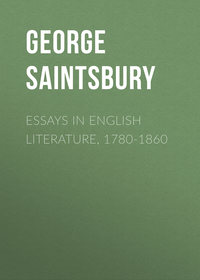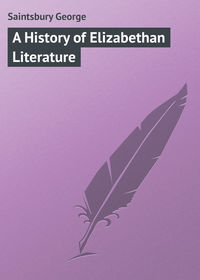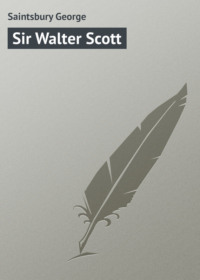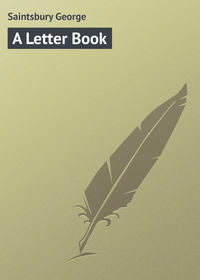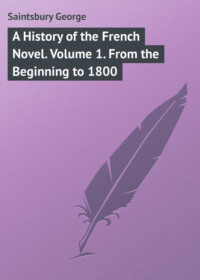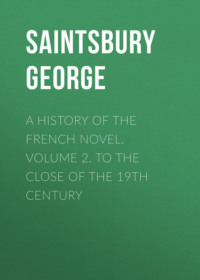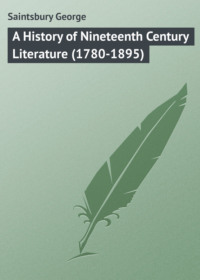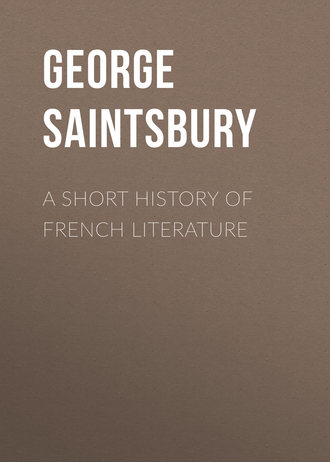 полная версия
полная версияA Short History of French Literature
A novelist of merit, slightly junior to these, was Madame Riccoboni (Marie Jeanne Laboras de Mézières), who was born in 1713, married an actor and dramatic author of little talent, and died at a great age in 1792. Her best works of fiction are Le Marquis de Cressy, Mylady Catesby, and Ernestine, with an exceedingly clever continuation (which, however, stops short of the conclusion) of Marivaux' Marianne. All these books are constructed with considerable skill, and are good examples of what may be called the sentimental romance. Duclos, better known now for his historical and historical-ethical work, was also a novel-writer at this period. The Lettres du Marquis de Roselle, of Madame Elie de Beaumont, rather resembles the work of Madame Riccoboni.
The works of the three principal writers who have just been discussed belong to the first half of the century, and do not exhibit those characteristics by which it is most generally known. Marivaux is indeed an important representative of the laborious gallantry which descended from the days of the précieuses– Fontenelle being a link between the two ages – and Prévost exhibits, in at least its earlier stage, the sensibility which was one of the great characteristics of the eighteenth century. But neither of them can in the least be called a philosophe. On the other hand, the philosophe movement, which dominated the middle and latter portions of the age, was not long in invading the department of fiction. Each of the three celebrated men who stood at its head devoted himself to the novel in one or other of its forms; while Montesquieu, in the Lettres Persanes, came near to it, and each of the trio themselves had more or fewer followers in fiction.
Voltaire.
No long work of prose fiction stands under the name of Voltaire, but it may be doubted whether any of his works displays his peculiar genius more fully and more characteristically than the short tales in prose which he has left. Every one of them has a moral, political, social, or theological purpose. Zadig, 1748, is, perhaps, in its general aim, rather philosophical in the proper sense; Babouc, 1746, social; Memnon, 1747, ethical. Micromegas, 1752, is a satire on certain forms of science; the group of smaller tales, such as Le Taureau Blanc, are theological or rather anti-theological. L'Ingénu, 1767, and L'Homme aux Quarante Écus (same date), are political from different points of view. All these objects meet and unite in the most famous and most daring of all, Candide, 1758. Written ostensibly to ridicule philosophical optimism, and on the spur given to pessimist theories by the Lisbon earthquake, Candide is really as comprehensive as it is desultory. Religion, political government, national peculiarities, human weakness, ambition, love, loyalty, all come in for the unfailing sneer. The moral, wherever there is a moral, is, 'be tolerant, and cultivez votre jardin,' that is to say, do whatsoever work you have to do diligently. But in all these tales the destructive element has a good deal the better of the constructive. As literature, however, they are almost invariably admirable. There is probably no single book in existence which contains so much wit, pure and simple, as the moderate sized octavo in which are comprised these two or three dozen short stories, none of which exceeds a hundred pages or so in length, while many do not extend beyond two or three. Nowhere is the capacity of the French language for persiflage better shown, and nowhere, perhaps, are more phrases which have become household words to be found. Nowhere also, it is true, is the utter want of reverence, which was Voltaire's greatest fault, and the absence of profundity, which accompanied his marvellous superficial range and acuteness, more constantly displayed.
Diderot.
No inconsiderable portion of the extensive and unequal work of Diderot is occupied by prose fiction. He began by a licentious tale in the manner, but without the wit, of Crébillon the younger; a tale in which, save a little social satire, there was no purpose whatever. But by degrees he, like Voltaire, began to use the novel as a polemical weapon. The powerful story of La Religieuse, 1760, was the boldest attack which, since the Reformation and the licence of Latin writing, had been made on the drawbacks and dangers of conventual life. Jacques le Fataliste, 1766, is a curious book, partly suggested, no doubt, by Sterne, but having a legitimate French ancestry in the fatrasie of the sixteenth century. Jacques is a manservant who travels with his master, has adventures with him, talks incessantly to him, and tells him stories, as also does another character, the mistress of a country inn. One of these stories, the history of the jealousy and attempted revenge of a great lady on her faithless lover by making him fall in love with a girl of no character, is admirably told, and has often since been adapted in fiction and drama. Other episodes of Jacques le Fataliste are good, but the whole is unequal. The strangest of all Diderot's attempts in prose fiction – if it is to be called a fiction and not a dramatic study – is the so-called Neveu de Rameau, in which, in the guise of a dialogue between himself and a hanger-on of society (or rather a monologue of the latter), the follies and vices, not merely of the time, but of human nature itself, are exposed with a masterly hand, and in a manner wonderfully original and piquant.
Rousseau.
Crébillon the Younger.
Neither Voltaire, however, nor Diderot devoted, in proportion to their other work, as much attention to prose fiction as did Jean Jacques Rousseau. Even the Confessions might be classed under this head without a great violation of propriety, and Rousseau's only other large books, La Nouvelle Héloïse, 1760, and Emile, 1764, are avowed novels. In both of these the didactic purpose asserts itself. In the latter, indeed, it asserts itself to a degree sufficient seriously to impair the literary merit of the story. The second title of Emile is L'Education, and it is devoted to the unfolding of Rousseau's views on that subject by the aid of an actual example in Emile the hero. It had a great vogue and a very considerable practical influence, nor can the race of novels with political or ethical purposes be said to have ever died out since. As a novel, properly so called, it has but little merit. The case is different with Julie or La Nouvelle Héloïse. This is a story told chiefly in the form of letters, and recounting the love of a noble young lady, Julie, for Saint Preux, a man of low rank, with a kind of afterpiece, depicting Julie's married life with a respectable but prosaic free-thinker, M. de Wolmar. This famous book set the example, first, of the novel of sentiment, secondly, of the novel of landscape painting. Many efforts have been made to dethrone Rousseau from his position of teacher of Europe in point of sentiment and the picturesque, but they have had no real success. It is to La Nouvelle Héloïse that both sentimental and picturesque fictions fairly owe their original popularity; yet Julie cannot be called a good novel. Its direct narrative interest is but small, its characters are too intensely drawn or else too merely conventional, its plot far too meagre. It is in isolated passages of description, and in the fervent passion which pervades parts of it, that its value, and at the same time its importance in the history of novel-writing, consist.
Some lesser names group themselves naturally round those of the greater Philosophes in the department of prose fiction. Voltaire's style was largely followed, but scarcely from Voltaire's point of view, and those who practised it fell rather under the head of Conteurs pure and simple than of novelists with a purpose. The prose Conte of the eighteenth century forms a remarkable branch of literature, redeemed from triviality by the exceptional skill expended on it. The master of the style was Crébillon the younger, in whom its merits and defects were both eminently present. Son of the tragic author, Crébillon led an easy but a rather mysterious life, married an Englishwoman, and was supposed by his friends to be dead long before he had actually quitted this world. His works, of which it is unnecessary to mention the names here, exhibit the moral corruption of the times in almost the highest possible degree. But they abound in keen social satire, in acute literary criticism, and in verbal wit. What is more, they show an extraordinary mastery of the art of narrative of the lighter kind. Around Crébillon are grouped a large number of writers, some of whom almost rival him in delicate literary knack, and most of whom equal him in perverse immorality of subject and tone. Much of the formal exercise of this tale literature was a tradition from the slightly earlier school of fairy tale-writing, which has already been noticed. Voisenon, Caylus, Boufflers, Moncrif (the most original and most eccentric of all), La Morlière, are names of this class. Their prose may, on the analogy of Vers de Société, be called Prose de Société, and of a very corrupt society too. But its formal excellence is considerable.
Of exceptional excellence among the short tales of this time, and free from their drawbacks, is the Diable Amoureux, 1772, of Cazotte, a singular person, strongly tinged with the 'illuminism,' or belief in occult sciences and arts, which was a natural result of the philosophe movement. Cazotte's melancholy story has a place in all histories of the French Revolution, and his name was (probably) borrowed by La Harpe for a bold and striking apologue, the authenticity or spuriousness of which is very much a matter of guess-work. The Diable Amoureux is a singularly powerful story of its kind, uniting, in the fashion so difficult with tales of diablerie, literary verisimilitude and exactness of presentation with strangeness of subject.
Voltaire's chief pupils and followers, while taking his own view of the utility of the prose tale for controversial purposes, followed another model for the most part in point of form. The immense influence of Télémaque was felt by Voltaire himself, though in his case it resulted in history pure and simple. Marmontel in his Bélisaire, and Florian in his Numa Pompilius and Gonsalve de Cordoue, returned to the historical romance. Something of the same class, though based upon much more solid scholarship, was the Voyage du Jeune Anacharsis of the Abbé Barthélemy. All these books, like their predecessor, have somewhat passed out of the range of literature proper into that of school books. They are, however, all good examples of the easy, correct, and lucid, if cold and conventional, tongue of the later eighteenth century.
Bernardin de Saint-Pierre.
Rousseau had a far more important disciple in fiction. Jacques Henri Bernardin de Saint-Pierre was born at Havre in 1737. He was by profession an engineer, and both professionally and on his private account wandered about the world in a curious fashion. At last he met Rousseau, and the influence of Jean Jacques developed the sentimental morality, the speculative republicanism, and the ardent, if rather affected, love of nature which had already distinguished him. His best book, Paul et Virginie, is perhaps the only one of his works which can properly be called a novel; but La Chaumière Indienne deserves to be classed with it, and even the Études de la Nature are half fiction. Paul et Virginie was written when the author's admiration of nature and of the savage state, imbibed from Rousseau or quickened by his society, had been further inflamed by a three years' residence in Mauritius. Like the books mentioned in the last paragraph, Paul et Virginie has lost something by becoming a school-book, but its faults and merits are in a literary sense greater than theirs. The over-ripe sentiment and the false delicacy of it will always remain evidence of the stimulating but unhealthy atmosphere in which it was written. But it cannot be denied that, both here and elsewhere in Bernardin de Saint-Pierre, there is a very remarkable faculty of word-painting, and also of influencing the feelings.
Restif de la Bretonne.
The later eighteenth century saw a vast number of novelists and novels, few of which were of much literary value, while most of them displayed the evil influences of the time in more ways than one. Dulaurens, a vagabond and disreputable writer, is chiefly remembered for his Compère Mathieu, a book presenting some points of likeness to Jacques le Fataliste, and like it inspired partly by Sterne, and partly by Sterne's master, Rabelais. Writers like Louvet and La Clos continued the worst part of Crébillon's tradition without exhibiting either his literary skill or his wit. A much more remarkable name is that of Restif de la Bretonne, who has been called, and not without reason, the French Defoe. He was born at Sacy in Burgundy in 1734, and died at Paris in 1806. Although of very humble birth, he seems to have acquired an irregular but considerable education, and, establishing himself early in Paris, he became an indefatigable author. About fifty separate works of his exist, some of which are of great extent, and one of which, Les Contemporaines, includes forty-two volumes and nearly three hundred separate articles or tales. Restif, whose entire sanity may reasonably be doubted, was a novelist, a philosopher, a social innovator, a diligent observer of the manners of his times, a spelling reformer. His work is for the most part destitute of the most rudimentary notions of decency, but it is apparently produced in good faith and with no evil purpose. His portraiture of manners is remarkably vivid. It is in this, in his earnest but eccentric philanthropy, and in his grasp of character, not seldom vigorous and close, that he chiefly resembles Defoe. He has been called in France the Rousseau of the gutter, which also is a comparison not without truth and instruction, despite the jingle ('Rousseau du ruisseau') by which it was no doubt suggested.
The law which seems to have ordained that, though the eighteenth century in France should produce no masterpiece in fictitious literature, or only one, all the most distinguished literary names should be connected with fiction, extended to the long and, in a literary sense, dreary debateable land between the eighteenth century itself and the nineteenth. Of this period the two dominant names are beyond question those of Chateaubriand and of Madame de Stael. Both attempted various kinds of writing, but some of the most important work of both comes under the heading of the present chapter, and both as literary figures are best treated here.
Chateaubriand.
François Auguste de Chateaubriand was born at Saint Malo, where he is now buried, in 1768, and died in 1848. He belonged to a family which was among the noblest of Britanny and of France, but which was not wealthy, and he was a younger son. Intended at first for the navy, he was allowed, at the outbreak of the Revolution, to indulge his fancy for travelling, and journeyed to North America. There he learnt the anti-monarchical turn which things had taken in France. He at once returned and joined the emigrants at Coblentz. He was seriously wounded at the siege of Thionville, and had some difficulty in making his way, by Holland and Jersey, to England, where he lived in great poverty. Chateaubriand's acceptance of the Legitimist side had been but half-hearted, and his first published work, Sur les Révolutions Anciennes et Modernes, still expresses the peculiar liberalism which – it is sometimes forgotten – was much more deeply rooted in the French noblesse of the eighteenth century than in any other class. This opened the way to his return at the time that Napoleon, then entering on the consulate, endeavoured, by all the means in his power, to conciliate the emigrants. The Génie du Christianisme, which had been preceded by Atala (a kind of specimen of it), was his first original, and his most characteristic, work. This curious book, which it is impossible to analyse, consists partly of a rather desultory apology for Christian doctrine, partly of a series of historical illustrations of Christian life: it appeared in 1802. It suited the policy of Napoleon, who made Chateaubriand, first, secretary to the Roman Embassy, and then ambassador to the Valais. But Chateaubriand had never given up his legitimism, and the murder of the Duke d'Enghien shocked him irresistibly. He at once resigned his post, and thenceforward was in more or less covert opposition, though he was not actually banished from France. Pursuing the vein which he had opened in the Génie, he made a journey to the East, the result of which was his Itinéraire de Paris à Jerusalem, and the unequal but remarkable prose epic of Les Martyrs. This, the story of which is laid in the time of Diocletian, shifts its scene from classical countries to Gaul, where the half-mythical heroes of the Franks appear, and then back to Greece, Rome, and Purgatory. The fall of Napoleon opened once more a political career, of which Chateaubriand had always been ardently desirous. His pamphlet, De Bonaparte et des Bourbons, was, perhaps, the most important literary contribution to the re-establishment of the ancient monarchy. During the fifteen years which elapsed between the battle of Waterloo and the Revolution of July, Chateaubriand underwent vicissitudes due to the difficulty of adjusting his liberalism and his legitimism, sentiments which seem both to have been genuine, but to have been quite unreconciled by any reasoning process on the part of their holder. Yet, though he had again and again experienced the most ungracious treatment both from Louis XVIII. and Charles X., the July monarchy had no sooner established itself than he resigned his positions and pensions, and took no further official part in political affairs during the rest of his life. In his latter days he was much with the celebrated Madame Recamier, and completed his affectedly-named but admirable Mémoires d'Outre Tombe, – an autobiography which, though marred by some of his peculiarities, contains much of his most brilliant writing. Of the works not hitherto noticed, René, Le Dernier Abencérage, Les Natchez, and some sketches of travels and of French history, are the most remarkable.
For some thirty years, from 1810 to 1840, Chateaubriand was unquestionably the greatest man of letters of France in the estimation of his contemporaries. His fame has since then diminished considerably, and much has been written to account for the change. It is not, however, very difficult to understand it. Chateaubriand is one of the chief representatives in literature of the working of two conditions, which, while they lend for the time much adventitious importance to the man who takes full advantage of them, invariably lead to rapidly-diminished estimates of him when they have ceased to work. He was a representative at once of transition and reaction – of transition from the hard and fast classical standards of the eighteenth century to the principles of the romantic and eclectic schools, of reaction against the philosophe era. He was one of the earliest and most influential exponents of the so-called maladie du siècle, of what, from his most illustrious pupil, is generally called Byronism. His immediate literary teachers were Rousseau and Ossian. He was not a thoroughly well-educated man, and he was exceptionally deficient in the purely logical and analytic faculty as distinguished from the rhetorical and synthetic. What he could do and did, was to glorify Christianity and monarchism in a series of brilliantly-coloured pictures, which had an immense effect on an age accustomed to the grey tints and monotonous argument of the opposite school, but which, to a posterity which is placed at a different point of view, seem to lack accuracy of detail and sincerity of emotion. Nevertheless Chateaubriand, if not a very great man, was a very great man of letters. His best passages are not easily to be surpassed in brilliancy of style and vividness of colouring. If the sentiment of his René seems hollow now-a-days, it must be remembered that this is almost entirely a matter of fashion and of novelty. The Génie du Christianisme, despite many defects of taste, more of insight, and most of mere learning, remains one of the most eloquent pleadings in literature, and not one of the least effective; while the Itinéraire is the pattern of all the picturesque travels of modern times. All these works, and most of the rest, are practically novels with a purpose. Even in the autobiography the historic part is entirely subdued and moulded to the exigencies of the dramatic and narrative construction. Regarded merely as an individual writer, Chateaubriand would supply a volume of 'Beauties' hardly inferior to that which could be gathered from any other prose author in France. Regarded as a precursor, he deserves far more than any other single man, and almost more than all others put together, the title of father of the Romantic movement.
Madame de Stael.
His chief rival in the literature of the empire was also essentially, though not wholly or professedly, a novelist. Anne Louise Germaine Necker, who married a Swedish diplomatist, the Baron de Stael Holstein, and is, therefore, generally known as Madame de Stael, was the daughter of the great financier Necker, and of Susanne Curchod, Gibbon's early love. She was introduced young to salon life in Paris, and early displayed ungovernable vanity, and much of the sensibilité of the time, that is to say, an indulgence in sentiment which paid equally little heed to morality and to good sense. Her marriage was one purely of convenience: and while her husband, of whom she seems to have had no reason whatever to complain, obtained some wealth by it, she herself secured a very agreeable position, inasmuch as the king of Sweden pledged himself either to maintain M. de Stael in the Swedish embassy at Paris, or to provide for him in other ways. She approved the early stages of the Revolution, but was shocked at the deposition and death of the king and queen. Whereupon she fled the country. Before she was thirty she had written various books, Lettres sur J. J. Rousseau, Défense de la Reine, De l'Influence des Passions, and other pieces of many kinds. When the influence of Napoleon became paramount, Madame de Stael, who had returned to Paris, found herself in an awkward position, for she was equally determined to say what she chose, and to have gallant attentions paid to her, and Napoleon would not comply with either of her wishes. She, therefore, had to leave France, but not before she had published her first romance, Delphine, and a book on literature. She now travelled for some years in Germany and Italy in the company of Benjamin Constant, who was the object of one of her numerous accesses of affection. Corinne, her principal novel, and her greatest work but one, appeared in 1807, her book De l'Allemagne being suppressed in Paris, whither she had returned, but which she soon had to leave again. The Restoration gave her access once more to France, and enabled her to resume possession of property which had been unjustly seized, but she died not long afterwards, in 1817. Her Dix Années d'Exil and her Considérations sur la Révolution Française were published posthumously, the latter being one of her chief works. She had married secretly, in 1812, a M. de Rocca, a man more than young enough to be her son.
The personality of Madame de Stael is far from being attractive owing to her excessive vanity, which disgusted all her contemporaries, and the folly which made a woman, who had never been beautiful, continue, long after she had ceased to be young, to give herself in life and literature the airs of a newest Héloïse. But she is a very important figure in French literature. Part of her influence, as represented by the book De l'Allemagne, does not directly concern us in this chapter; this part was mainly, but not wholly, literary. It was helped and continued, however, by her other works, especially by her novels, and, above all, by Corinne. This influence, put briefly, was to break up the narrowness of French notions on all subjects, and to open it to fresh ideas. Her political and general works led the way to the nineteenth century, side by side with Chateaubriand's, but in an entirely different sense. What Chateaubriand inculcated was the sense of the beauty of older and simpler times, countries, and faiths which the self-satisfaction of the eighteenth century had obscured; what Madame de Stael had to impress were general ideas of liberalism and progress to which the same century, in its crusade against superstition and its rather short-sighted belief in its own enlightenment, was equally blind. Delphine, which is in the main a romance of French society only, written before the author had seen much of any other world except a close circle of French emigrants abroad, exhibits this tendency much less than Corinne, which was written after that German visit – by far the most important event of Madame de Stael's life. Here, as Rousseau had inculcated the story of nature and savage life, as Chateaubriand was, at the same time, inculcating the study of Christian antiquity and the middle ages, so Madame de Stael inculcated the cultivation of æsthetic emotions and impulses as a new influence to be brought to bear on life. Her style, though not to be spoken of disrespectfully, is, on the whole, inferior to her matter. It is full of the drawbacks of eighteenth-century éloges and academic discourses, now tawdry, now deficient in colour, flexibility, and life, at one time below the subject, at another puffed up with commonplace and insincere declamation. Yet when she understood a subject, which was by no means invariably the case, Madame de Stael was an excellent exponent; and when her feelings were sincere, which they sometimes were, she was a fair mistress of pathos.


